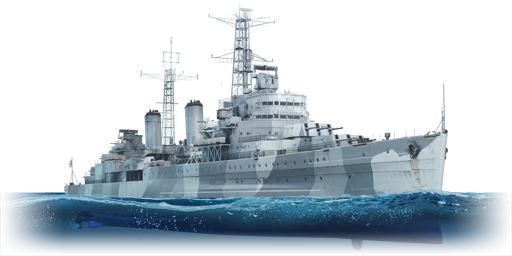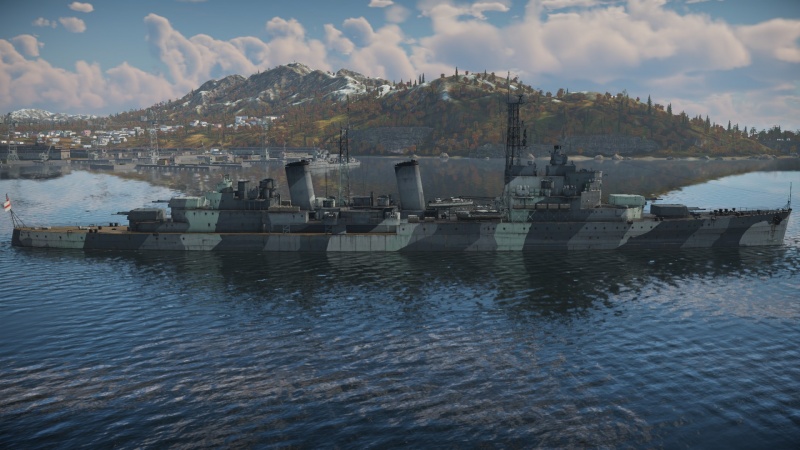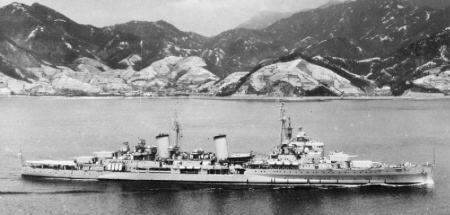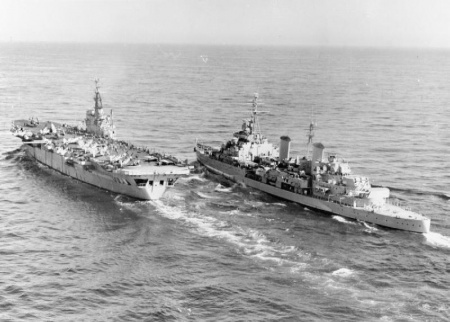HMS Belfast
Contents
Description
The Town-class, HMS Belfast (C35), 1959 is a premium rank IV British light cruiser with a battle rating of 5.7 (AB/RB/SB). It was introduced in Update 1.93 "Shark Attack".
General info
| Specification | Information |
|---|---|
| Crew (Complement): | 956 |
| Displacement: | 14,900 tons |
| Length: | 613 ft 6 in (186.99 m) overall |
| Beam: | 63 ft 4 in (19.3 m) |
| Draught: |
|
| Armour: |
|
| Installed power: | 80,000 shp (60,000 kW) |
| Propulsion: |
|
| Speed: | 32 knots (59 km/h) |
| Other: | Flagship of 10th Cruiser Squadron |
Survivability and armour
Talk about the vehicle's armour. Note the most well-defended and most vulnerable zones, e.g. the ammo magazine. Evaluate the composition of components and assemblies responsible for movement and manoeuvrability. Evaluate the survivability of the primary and secondary armaments separately. Don't forget to mention the size of the crew, which plays an important role in fleet mechanics. Save tips on preserving survivability for the "Usage in battles" section. If necessary, use a graphical template to show the most well-protected or most vulnerable points in the armour.
Mobility
The HMS Belfast has 80,000 shaft horsepower on its screws. This power is provided by four Admiralty oil-fired 3-drum boilers. The four propellers are driven by four Parsons single reduction geared steam turbines. This gives the Belfast a maximum forward speed of 32 knots (59 km/h).
Modifications and economy
Armament
Primary armament
The HMS Belfast comes with 12 x Ordnance BL 6 inch (152 mm) Mk XXIII naval guns. These guns are housed in 4 turrets of 3 guns each. Two turrets face forwards and two are facing backwards. The guns have a rate of fire of 8 rounds per minute and fire three types of shells, one of which is the 6 inch CPBC SAPBC shell. This shell is an effective shell to fight other cruisers. Another one is an HE shell, use this shell to fight destroyers and small patrol boats. HE can really shred a destroyer apart in 3 salvos. The last shell is the timed HE shell which can be used to fight aircraft. However, this is not an effective method so taking this shell for the main armament is not recommended. Take around 600 shells of HE and 1,800 shells of SAP. You will never be out of ammo because the Belfast can carry around 2,200 shells. So another option is to take less shell's to minimize the chance to get ammo wrecked. 400 HE and 800 AP shells should be more than enough.
Secondary armament
Belfast has 4 secondary turrets (2 at each side) containing two Ordnance QF 4 inch (102 mm) Mk XVI dual-purpose guns. They can fire 4 types of shells, an AP shell, HE shell, timed (fuzed) HE-shell and proximity (fused) HE-shell. Taking the AP shells is recommended (to fight destroyers and smaller patrol boats) as well as proximity HE-shells to fight arcraft. The ratio AP:proximity-HE should be around 40:60.
Anti-aircraft armament
When fighting aircraft in the Belfast, you have both the secondary Ordnance QF 4 inch Mk XVI turrets and also 40 mm QF Mark V guns in six dual-mounted turrets. There is no ammunition you can select between, you will only get the default HE belt, but don't dismay, this belt is very effective when shooting down planes.
Usage in battles
HMS Belfast is a very strong cruiser and gives you the ability to fight other cruisers very effectively. However, there are very dangerous cruisers which should be your main priority to kill. These cruisers are the USS Brooklyn (CL-40) and USS Helena (CL-50). These cruisers can fire 15 shells each salvo and do significant damage to your ship. So when starting a match, make sure you try and disable or destroy these cruisers as soon as possible.
A typical cruiser game starts very slow. You and your teammates are spawning in the back and far away from the light fleet. As a cruiser, you need your light fleet because they can cap and win the game. As a cruiser, a lot of places on the map are not accessible. Your ship has a draught of 17 feet 3 inches (5.3 m) so you can't go anywhere you want. Your main goal is to achieve supremacy over the other team in terms of cruiser and destroyer power. Destroyers are very vulnerable against other cruisers so your main goal is to fight these cruisers. Destroyers should help the patrol boats with capping and getting an advantage. When destroying other cruisers, make sure your destroyer can fulfil this role. This also means that when the majority of the enemy cruisers are destroyed, you should be focusing on shooting down enemy destroyers. This increases the chance of the survivability of a small fleet to capture the points. Don't be that cruiser captain that is desperate to kill another cruiser that is far away from your fleet and far away from a capture point. The fleet needs you because you can tank a lot of shots. Stick with your team, make sure that they don't need to worry about big guns so you achieve a victory.
Pros and cons
Pros:
- Powerful main armament
- Strong armour (citadel is very well protected)
- Effective AA protection
- Doesn't flood very easily
- Decent manoeuvrability
Cons:
- Doesn't have any torpedo armament
- Mediocre turret protection
- Weak bridge protection
- Mediocre barbettes
History
HMS Belfast (C35) was a Town-class cruiser of the Royal Navy built just before the Second World War. Designed as a counter to the Japanese Mogami class, Belfast carried a substantial main armament and had an improved anti-aircraft armament compared to the previous Town-class cruisers. Belfast had a storied service career, almost sunk by a naval mine in 1939 but returned to service later in the Second World War. She served in the Arctic theatre, where she escorted convoys and assisted in the destruction of the battleship Scharnhorst. Belfast later participated in the Korean war and received numerous refits to her armament and sensors. She was retired in 1963, and is now a museum ship moored on the Thames in London, UK.
Design and development
After the construction of the Japanese Mogami class, the British urgently needed a modern light cruiser to complement their older Arethusa and Leander-class cruisers. As such, they designed a new class of light cruiser, which would become the Town class, named after various towns and cities in the United Kingdom. A total of three subclasses would be designed - the Southampton, Gloucester and Edinburgh subclasses. Belfast was the second of two Edinburgh - class cruisers, the other being HMS Edinburgh herself. Compared to the other Towns, they had a longer hull, which was intended to house a new quadruple turret allowing for a total of sixteen main guns. However, this idea was eventually shelved due to difficulties in producing an effective turret. As a result, Belfast retained the twelve-gun main armament scheme of the previous Towns, but carried an additional pair of 4-inch dual AA guns as well as several more 40 mm Pom Pom guns.
Belfast displaced 11 550 tons standard and almost 15 000 tons full. Her crew complement initially consisted of 881 crewmembers, though this number varied depending on time. Belfast carried a main armament of twelve 6-inch (152) mm guns in four triple turrets, two fore and two aft; firing at up to 8 rounds per minute (RPM) each, the ship was capable of firing 96 RPM using all main guns. Belfast was initially equipped with twelve 4-inch (102 mm) secondary DP guns, sixteen 40 mm Pom Pom guns in two octuple mountings along with two quadruple vickers machine guns for anti-aircraft defence - this armament was improved over the course of her service career. Belfast also carried two triple 533 mm torpedo tubes. Powered by steam turbines developing 80 000 shaft horsepower, she was capable of 32 knots (59 km/h).
Operational history
After her commissioning on August 5th 1939, Belfast joined the Home Fleet, and was soon involved with the naval blockade of Germany following the start of the Second World War. She intercepted two German blockade runners, earning her crew members a substantial amount of prize money. However, on November 10th 1939, Belfast struck a mine during exercises in the Firth of Forth. The explosion killed one crewmember and wounded 20, and caused serious damage to the ship itself. Most importantly, her keel had been severely damaged and bent upwards. The massive repairs would take almost two and a half years to complete; during this time, Belfast had her anti-aircraft armament strengthened with 18 20 mm Oerlikon cannons, and received additional armour plating.
Following her recommissioning in November of 1942, Belfast was made the Flagship of the 10th Cruiser Squadron, tasked with escorting Arctic convoys to the Soviet Union. In December of 1943, Belfast was escorting convoy JW 55B when they encountered the battlecruiser Scharnhorst. After a long night engagement, Scharnhorst was sunk by gunfire from the battleship Duke of York. Belfast played an important role in this engagement, shadowing the Scharnhorst using her radar to allow for her interception and eventual destruction by the British task force.
In 1944, Belfast participated in the D-Day landings, providing artillery support at Gold and Juno beaches. She received a refit in April of 1945, with two of her dual 4-inch turrets removed in exchange for more anti-aircraft guns and advanced radar systems. She sailed to the Pacific to join the British Pacific Fleet, and was serving as the flagship of the British 2nd Cruiser Squadron when the Japanese surrendered. After the war, Belfast remained in the Pacific with the British Far East squadron at Hong Kong, and was visiting Hakodate, Japan when the Korean War broke out.
With the outbreak of war on the Korean peninsula, Belfast joined the Allied forces and provided fire support as well as carrier escort abilities. By the end of the Korean war in 1953, she had fired over 8000 rounds from her 6-inch guns and steamed 130 000 km within the Korean combat zone. After returning home from the Korean conflict, Belfast was modernized one final time, revising her anti-aircraft armament to twelve 40 mm bofors guns in six dual mounts. Serving with the East Indies fleet until 1963, Belfast was expected to be scrapped, but was saved by the HMS Belfast Trust, an organization composed of former crewmembers and other individuals. On Trafalgar Day, October 21st 1971, she was formally opened to the public; she was purchased by the Imperial War Museum in 1978, and remains a museum ship today, anchored on the Thames in London near Tower Bridge.
Devblog
The light cruiser 'Belfast' was the next big step in shipbuilding design, following the Manchester cruisers, and, according to experts, this vessel (tied together with her sister ship, the cruiser Edinburgh) was the most advanced light cruiser in the Royal Navy of Great Britain during WWII. Belfast was laid down in 1938, and a year later, the cruiser came into service. The ship initially played a part in the British naval blockade against the German forces during WWII, however, in November 1939, the Belfast struck a mine and spent three years undergoing repairs, during which she also received a number of upgrades.
The modernised light cruiser was then deployed to escort Arctic convoys heading to the USSR, where she fought the German fleet for the first time. In June 1944, the Belfast provided cover for the US landing troops on the well-known D-Day, which took place in Normandy. At the end of World War II, Belfast was sent to the Pacific Ocean, where she joined the British Pacific Fleet. The next combat action the light cruiser saw was the Korean War, in which she participated from 1950 to 1952.
After taking part in a number of military operations and missions in Southeast Asia and the Pacific Ocean, the old war dog finally retired from the battlefield in 1963. The era of those ships was over and it seemed that the Belfast was essentially doomed to become scrap metal. However, fortune favoured the cruiser, as a group of enthusiastic war historians, among whom was a former Belfast commander, persuaded the British government to use the ship as a museum of war history. Since 1978, light cruiser Belfast has served as a branch of the Imperial War Museum and is permanently moored on the Thames in London.
Media
See also
Links to articles on the War Thunder Wiki that you think will be useful for the reader, for example:
- reference to the series of the ship;
- links to approximate analogues of other nations and research trees.
External links
References
- Dday.center. (2020). Historic Ships. Retrieved January 26, 2021, from http://www.dday.center/preserving-history-historic-ships-hms-belfast.html
- Mason, G. B., RN. (2004). HMS Belfast, British Light Cruiser. Retrieved January 26, 2021, from https://www.naval-history.net/xGM-Chrono-06CL-Belfast.htm
| Britain light cruisers | |
|---|---|
| Emerald-class | HMS Enterprise |
| Dido-class | HMS Dido |
| Leander-class | HMNZS Leander |
| Arethusa-class | HMS Arethusa |
| Town-class | HMS Belfast · HMS Liverpool · HMS Southampton |
| Tiger-class | HMS Tiger |
| Abdiel-class* | HMS Abdiel |
| Britain premium ships | |
|---|---|
| Motor torpedo boats | MTB-1(2) · MTB-422 · Fairmile D (5001) · HMS Gay Archer |
| Motor gun boats | MGB-75 · SGB Grey Goose |
| Gunboats | HMS Spey |
| Sub-chasers | LÉ Orla |
| Frigates | HMS Whitby |
| Destroyers | HMS Montgomery · HMS Valhalla · HMS Verdun · ORP Garland · HMS Jervis · HMCS Haida · HMS Mohawk · HMS Cadiz · HMS Diamond |
| Light cruisers | HMS Belfast |
| Battleships | HMS Iron Duke |







